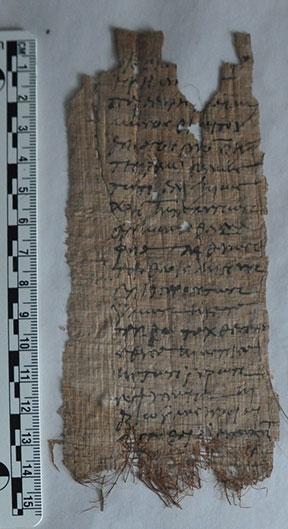Rare early Christian document among the finds
Source -http://www.decorahnewspapers.com/main.asp?SectionID=2&SubSectionID=13&ArticleID=33184

Nine papyri documents almost 2,000 years old were discovered recently by a student in the Luther College Archives (USA), where they had remained hidden in a cardboard box for decades.
Luther sophomore Brittany Anderson of Sparta, Wis. was examining the papers of the late Orlando Qualley, longtime professor of classics, the first vice president of Luther College (1934) and the first dean of the college (1946-64), when she came across the nine ancient documents among Qualley's letters and journals donated to the college in the 1980s.
The papyri-one of which, a libellus, is especially rare-date from the first to the fifth centuries A.D. and were apparently purchased by Qualley from an antiquities dealer when he was part of a University of Michigan archaeological excavation at Karanis, south of Cairo, in 1924-25.
"Luther College is incredibly fortunate to have in its possession the Qualley papyri, especially the libellus, a rare and invaluable find from the early centuries of Christian history," said Philip Freeman, Qualley Chair of ancient languages at Luther. "As soon as they are properly preserved, we hope to display all the papyri in our library for everyone to see. They provide a great opportunity for our students to examine a genuine piece of the ancient world."
The nine papyri, written in ancient Greek, measure from 5 to 20 centimeters in length and are in remarkably good shape, though all are fragmentary and quite fragile. Papyrus was the primary writing medium of the ancient world and was made from the interwoven fibers of the papyrus plant, which grows along the banks of the Nile River.
Emperor Decius
Upon finding the documents, Anderson contacted the Luther Classics Department faculty, who examined the papyri and in turn contacted the Papyrus Collection staff at the University of Michigan, one of the leading centers of papyrus study in the world, for help in identifying and analyzing the discoveries.
Several are accounting documents, but papyrologist Graham Claytor immediately identified one as a libellus dating from the first great Roman persecution of Christians beginning under Emperor Decius in the year 250.
Decius issued a decree that year ordering all inhabitants of the empire to offer a sacrifice to the gods as a show of loyalty. A libellus was a document given to a Roman citizen to confirm the performance of such a sacrifice. Christians were forbidden by their beliefs from performing these sacrifices and were thus subject to arrest, torture and execution for refusing to obey the emperor's decree. Pope Fabian was among those who refused to sacrifice and was subsequently killed by the Roman authorities.
The Luther College libellus bears the name of Aurelius Ammon, a servant of the well-attested Aurelius Appianus, a leading citizen of Alexandria, Egypt. It declares that Aurelius Ammon has sacrificed "in accordance with the orders" of the emperor.
The papyrus was probably part of a collection made in ancient times from the village of Theadelphia in Egypt's Fayum region. Only a few of these rare documents have been uncovered, and they are currently housed in research libraries in Hamburg, Berlin, Manchester, Florence and the University of Michigan. Now Decorah joins the list.
Luther College plans to work to preserve all the Qualley papyri and make them available online in digital format to scholars and people around the world.